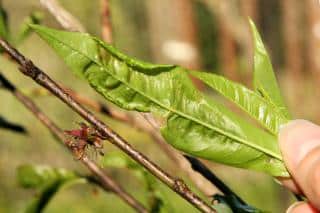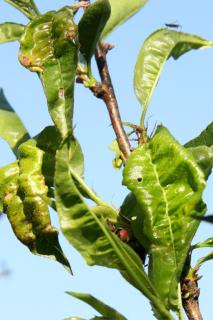

Peach leaf curl symptoms are waffled reddish leaves appearing on the peach tree.
Preventive care is required to avoid it.
This fungus (Taphrina deformans) is certainly the most fearful attack that peach trees or apricot trees can face, and will often hinder the tree as it tries to produce a normal peach harvest.
Although it is sometimes possible to control damage thanks to an adequate treatment applied at the right moment, peach leaf curl can nonetheless entirely destroy a harvest.
Here are our treatment guidelines against peach leaf curl:
This disease mainly infects the different peach varieties, but can also appear on apricot trees and almond trees.
 Leaves appear waffled and bulging.
Leaves appear waffled and bulging. The fungus responsible for peach leaf curl spends the winter in the form of spores lying on the buds and in hollows formed by the sprigs.
The fungus responsible for peach leaf curl spends the winter in the form of spores lying on the buds and in hollows formed by the sprigs.
That’s why treatment must be applied before this period, at the end of winter and at the beginning of spring, and best of all in fall, when leaves have fallen off.
Remember that for peach leaf curl, nothing is better than preventive treatment, it is the only effective way to treat against this fungus.
When leaves have fallen: pick leaves up and burn them to avoid having the disease overwinter in your garden.
Spray once more with Bordeaux mixture.
At most, propagation of the peach leaf curl can be slowed.
This regular care aims to reinforce fruit trees and thus increase their fruit bearing.
Provide organic fertilizer in spring and mulch the base of the tree to protect roots from frost spells in winter and from heat in summer.
Read on about peach trees:
Strange but we have three peach trees in a row, a Hale Haven a Red Haven an a Alberta, the Red Haven which is about 8 ft. tall in between the other two got hit hard with curly leaf, the whole tree was infected with the exception of a few leaves on top, I could see where the other two were becoming infected too, so I took Bonide Orchard Spray put one quarter of a pint bottle to 10 gallons of water soaked all three trees down with it, and it stopped the curly leaf in its tracks. The one who had lost its leaves is now re-leaved out and there is no curly leaf to be seen on the other two and the peaches look beautiful, these were sprayed when the peaches had just emerged from the blossom, some as big as a dime.
Yes, it’s very true that each variety will resist disease in very different manners. That’s the whole point of cross-pollination and breeding, actually: selecting traits like disease resistance from individual plants to increase resistance in following crops. Good to know that the Hale Haven and the Alberta are better at resisting the leaf curl. Indeed, infection risk was likely the same for the three trees, but only the middle one suffered most.
what is a Bordeaux mix
Hi Frank! Bordeaux mix is a powder that you mix into water. The most important ingredient is copper, which is a natural fungicide (it kills fungus and mushrooms). Here is a detailed article on bordeaux mix that explains what it is and how and when to use it. It’s important not to use too much of it, nor too often, even if it’s natural, because the copper accumulates in the soil and in the end, having too much of it is detrimental to soil health.
I have huge peach tree in my back garden that produced beautiful sweet and juicy peaches.Unfortunatly I noticed today that it is unfected with peach curl.I was covered in blossoms and now the leaves are forming .What can I do to save the crop and the tree ?
Hi Lynn, the answer to this is Bordeaux mixture. Prepare a dose and spray the tree thoroughly (don’t increase the dosage, but just make sure you spray the whole tree well (not easy for a big tree…). The next day, prune and remove those branches and leaves that are most infected (burn these), since the disease partly spreads from what is already infected. Once that is done, spray again once with the mixture. And then, cross your fingers and repeat the spraying every two weeks.
Over the Summer and Fall, be mindful to pick and burn anything that comes from the tree, since it might be hosting spores. Once leaves have fallen off, spray with Bordeaux mix once again and then follow the recommendations in the article about early treatment in Spring. Since you now know that peach leaf curl circulates in your area, you’ll have to keep up with the preventive spraying every year, but it should prevent the sickness from taking hold on your tree.